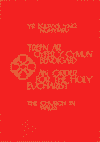Y Cymun Bendigaid
 A package containing a new book landed through my letter box a couple of days ago. It was a copy of the newly-authorized version of the Eucharist of the Church in Wales, published just in time for a meeting of the Church’s Governing Body in September.
A package containing a new book landed through my letter box a couple of days ago. It was a copy of the newly-authorized version of the Eucharist of the Church in Wales, published just in time for a meeting of the Church’s Governing Body in September.
 (The Archbishop of Wales, the Most Revd Barry Morgan, can be seen at the meeting using what looks like a copy of the altar edition of the book in this picture.)
(The Archbishop of Wales, the Most Revd Barry Morgan, can be seen at the meeting using what looks like a copy of the altar edition of the book in this picture.)
The arrival of this book was a significant moment for me — because I had designed and typeset it. Having laboured long and hard over the text and layout, over page breaks and line breaks, vertical and horizontal spacing, typeface, kerns and ligatures, page numbers and goodness knows what else, here at last was the finished product.
This is always an exciting event: to hold in your hands the result of your own craftsmanship, your own hard work, and to be able to see for the first time whether it has actually worked, whether you have achieved the effect that you wanted — in this case clarity and beauty combining tradition and modernity.
Of course, many people had contributed to this volume, in ways significantly more important than I had. Liturgists had worked on drafts, revision committees and the Governing Body had considered it, and altered it to produce the final authorized text; others had created the cover (by Leigh Hurlock) and the calligraphy (by Shirley Norman); and the printer (Biddles) had produced the printed and bound books. But I shall remember the time spent designing a layout that works, selecting typefaces, playing with type size, and different combinations of bold and italic and roman, caps and small caps, creating custom ligatures (Welsh requires an ‘fh’ ligature which did not exist in the selected face, so I had to design one myself in roman, italic, bold and bold italic), and of course proofreading the text over and over again. Proofreading, especially of the parallel Welsh text, was also done by people at the provincial office of the Church in Wales. All in all, the result is a book to be very pleased with, I think.
And then after all that, despite all the care that has gone into its production, you begin to notice the mistakes. Here and there, dotted around, are little glitches that have escaped the proofreading. It’s amazing that you can proofread a text so many times, both on screen and on paper proofs, and yet the minute you pick up the finished product you find a few more mistakes.
I suppose life is like that — you cannot produce the perfect work, there are always a few little things wrong. At least with a book there is a chance to correct any errors at the next printing! Mistakes in life, on the other hand, very often have to be lived with.
And we get a training day on it this Monday in the diocese of St David’s.
thanks Diolch etc
If you are using the Welsh text, then there are a number of misprints in the Welsh. These (and a handful of glitches in the English) will be corrected in a second impression, which should be out shortly, the first impression having sold out in just a few weeks. As I type this comment I am burning a CD ready for press.
Dear Simon,
Blessings prayed for the book you labored to design. As an American Episcopalian, I will likely have little occasion to use the book, but as a bookseller, I know the pleasure of a book well made (and in this case, one that serves the greater glory of God). Intrigued as I am by Celtic languages, I am happy that it is a dual text.
I knew that you put together this website, but I had not followed any of the threads before. I am impressed, so far, with the civil quality of the discourse here.
I will check in from time to time. Thanks for this effort.
Georgia DuBose
Harpers Ferry, WV